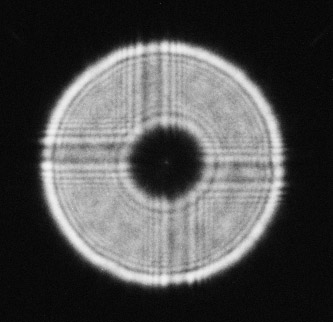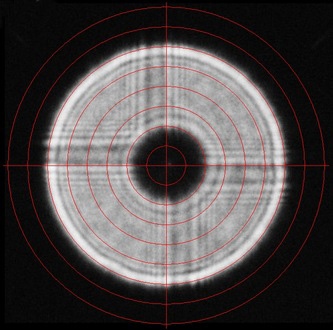Collimating by star test
When a Newtonian telescope is permanently mounted in an observatory, with an imaging camera in place,it is very tedious to have to remove the camera and check the collimation with a laser collimator, Cheshire eyepiece and so on.
The careful alignment of the camera will be lost, and new flat frames will have to be taken.
A useful method is to aim at a reasonably bright star, and de-focus the camera by a considerable amount.
The resulting image will be something like this:
| The central circular dark hole is caused by the
obstruction of the secondary mirror. If the telescope is well collimated, this hole will be concentric with the outer margin of the diffraction pattern. |
 |
|
| Placing rings over the image shows the
mis-alignment clearly. |
 |
The three collimating screws (bolts, nuts) behind the primary mirror, can now be adjusted to
bring the hole to the centre.
On my scope I labelled the wingnuts 'A', 'B' and 'C'.
I found that with my telescope, wingnut C moved the hole to the right when rotated clockwise.
(This was with the focuser moved outwards. If moved inwards, I suspect the movement might be opposite).
B and C moved the hole as shown below:

When a nut is turned, the image of the star will shift dramatically. A quarter-turn moved it right out of the field of view
so only a 20 degree turn was made each time.
Maxim's 'Point telescope here' function was used to return the star to the centre of the screen.
This is very important - the star must be dead centre!
Keeping the star in the centre is quite easy once you realise that a shift of a nut will move the whole star image
in the same direction in which you are trying to nudge the central hole.
In the above image it looks as if a small anticlockwise turn of nut B is required.
When I had finished this operation I took an image and examined it with CCDInspector.
The collimation appeared to be perfect!

This was just a bit of luck.
I took another 5 images and CCDInspector gave this report on the group:
A collimation reading of only 1.0 arcseconds is most acceptable!

Some Newtonian telescopes have an offset secondary mirror. The effect of this is to produce
an off-centre central hole, even when the telescope is perfectly collimated.
I checked this using Niels Noordhoek's Maskulator programme. The image below shows a simulated diffraction pattern
produced by a perfectly centred obstruction, and one that is displaced.
The solution to this problem is to make a circular mask which will fit over the central obstruction.
The mask is made sufficiently large to completely cover the offset secondary mirror.
I made a simple one from a piece of cardboard.
Once the collimation is completed, the mask can be removed.

The cardboard mask
